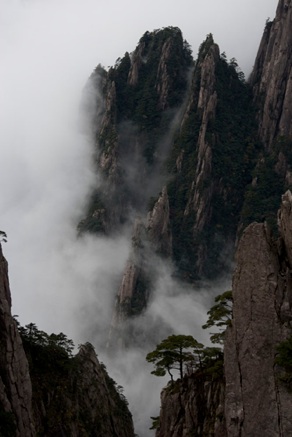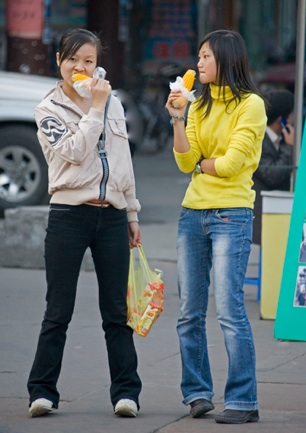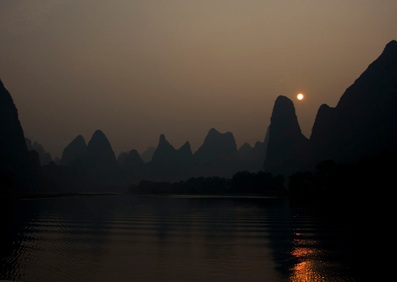Luminous Landscape 2005 China Workshop
We spent the next day in Huangshan town then left for Shanghai. The largest city in China is renowned for its forward looking stance and while it was the birthplace of communism, it is certainly embracing capitalism now. In fact, only the experienced eye will see any traces of the not-so-old system as Shanghai already has the buoyant yet rather worn look of places like New York where free enterprise reigned supreme for generations.
The team disbanded in Shanghai with some going back to America and Canada while others spread around China for an extended stay. I chose to remain one week in Shanghai to get acquainted with this incredible city. The weather wasn't too good and you kept being harassed in the streets by beggars and vendors which made good quality photography difficult, even though subjects abounded. A cruise on the Huangpu to the mouth of the Yangtze was my best photo opportunity, showing both the incredibly large industrial facilities and the intense life on the river.

9 March 2006
Signs of the development were everywhere, including at our next stop: the Yellow Mountains (Huang Shan). The natural scenery is spectacular, but so is the effort put into making it accessible. Stone paved paths, staircases and balconies snake across the mountains in miles of safe (if exhausting) walks for the visitors. Sometimes the path hangs on the sides of sheer cliffs and it is difficult to imagine how they were built in such inaccessible locations. The weather is very variable and while our first afternoon was fine enough, the next day was completely overcast, which in the mountains means we were actually inside the clouds. The visibility was less than 15 meters and only the most courageous managed to grab a few moody shots that day. As rain was expected on the next day, we made plans to pack early. Our good luck, however continued and by morning, the visibility was good again and we were treated to the full display of the "sea of clouds" weaving through the peaks. It was spectacular and you just had to stand still to see the scenery change before you. Those two hours around dawn were worth the whole trip.


I came back from the workshop with almost 5000 shots and a vastly improved technique in several areas my concentration on wildlife photography had left weak. While it was sobering to see the results the other, much better photographers could get, the opportunities abounded to try and match their technique. We started in Hong Kong where a rather foggy weather made shooting uninteresting. Having spent years there, I am also too familiar with the city to be excited by its exoticism. The first step of the trip was Guilin, to be reached via a combination of bus and aeroplane. The region, as all our targets, is a tourist magnet, extremely popular with the Chinese themselves who will visit it by the tens of thousands. Even among the crowd, the sculpted hills have lost none of their appeal, the surrounding countryside remains timeless and the boat ride on the river Li is still awe inspiring. As we had our own transportation at all times, including the boats (but unfortunately not the planes...) it was always easy to stop to set up tripods whenever an opportunity presented itself. Our big "set" shot was to be the rising moon at dusk over the hills and a fair amount of time was spent scouting the best location for the picture. When night prevented any more photography, we returned for a very short night at the hotel in order to be back in the same location about an hour before dawn. The spare time was used to visit different towns and villages and play with street photography. What has become an increasingly regulated and dangerous speciality in the western world is still easy and fruitful in China. Many people are used to photographers and will just make clear their wish not to be photographed or to be paid for it. Most, though, will be interested, amused or at worst neutral and will provide wonderful candid subjects. The incredible economic development in China over the last few years means that even in fairly remote places, you will see people still living in the 18th century alongside 21st century city slickers; ox-driven carts beside Lexuses. Documenting this great contrast is a wonderful exercise, enhanced by the general optimism and the feeling that poverty is being driven out of the country at a fast pace.

www.luminous-landscape.com is one of the most popular photography web sites (if not the most popular) in the world. Its author, Michael Reichmann is a professional photographer specializing in fine art but conversant in all forms of photography. If he is not exhibiting he is writing articles, preparing books, special edition prints or leading workshops across the world. Those are highly sought after and I only secured a place on the China 2005 one by applying within two hours of the opening. The workshops are expensive, although not more than it would cost to organize such a trip independently, and appeal to dedicated and already experienced photographers. They are therefore not run as seminars, but more as "photo safaris" where everybody benefits from the common goal of finding the most picturesque locations and times. This is quite a serious endeavour as the trip itself has been scheduled to coincide with the right season, weather.. and moonrise times. It also means that no travelling will be spared to find the right locations and no sleep will be spared to get to the spot early enough for the "magical hour". Even though there is no formal teaching in the workshop, a tremendous amount of information is shared through osmosis between the different members. If one of the future destinations of the Luminous Landscape workshops appeals to you, go. It will be hard work but it will be fun and give you more photos opportunities than you could have found on your own.